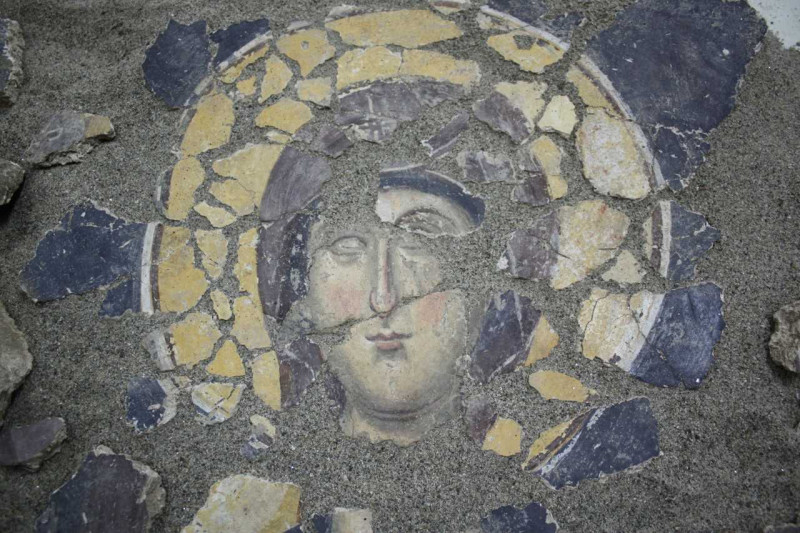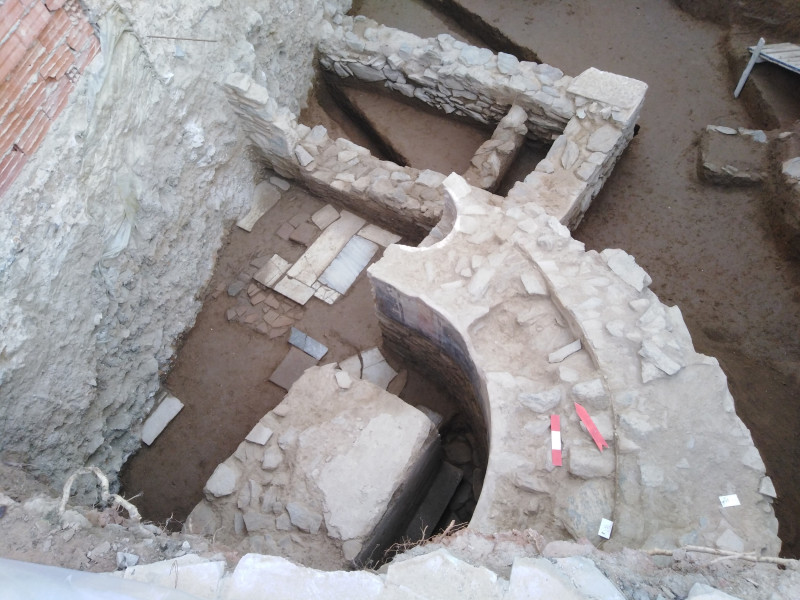The dating of the temple places it in the turbulent period of the history of Thessaloniki immediately after the Latin conquest
The Acropolis of Thessaloniki, since its very ancient foundation, was the strongest and last bastion of the city. It played a decisive role throughout its history, especially during the late Byzantine period, not as a simple district, but as the “God-guarded kula” with the brilliant holy temples in which the Archbishop officiated and the last refuge of the lords, such as secretaries sources deliver.
A few meters north of the exit gate from the Acropolis, in the vicinity of the focal point where the intermediate wall of the city meets the western part of the wall of the Acropolis and near the mighty towers with imperial inscriptions, in a rescue excavation of a plot at 5 Stergiou Polydorou Street, an unknown person was discovered in the research a temple of the Paleologian times, with a dense cemetery of the same period.
In particular, approximately half of a multi-faceted, calculated as five-sided, alcove of the sacred Step with two construction phases was revealed. The wall of the niche, built with stones and bricks, many of which are sealed with crosses, has a negligent brick-enclosed building system and soil binding material. At a very short distance from the frescoed wall of the niche, the Holy Altar itself was revealed. The altar is built in the form of a solid cube.
From the structural features of the superstructure of the alcove of the Sacred Step, its pictorial decoration and its mobile equipment, the excavation revealed valuable elements. Between the wall of the alcove and the Holy Altar, a cross-shaped marble vessel was discovered that constituted the inauguration of the second construction phase. Both on the surface of the curved wall and in the niche of the Proposition, part of the pictorial decoration was revealed in a good state of preservation. From the illustration of the Intention, the lower part of the representation of the Extreme Humiliation of Christ was preserved. From the illustration of the arch of the sanctuary, the representation of Melismus was preserved in fragments. Many fragments of luxurious frescoes from the sanctuary area were found in the destruction layer of the niche. The splits also include several that have a gold leaf coating. From these cracks, it was possible to partially reconstruct the image of the Virgin Platytera, which undoubtedly adorned the upper fresco zone of the niche. The fresco of Platytera in the temple of Polydoros is a masterpiece of the second decade of the 14th century (1310-1320), and artistically belongs to the high Paleologian art of Thessaloniki with analogues in representations in the temple of Agios Panteleimon, of the 13th – 14th century and Nikolaou Orfanou (1310-1320).
The chronological indications resulting from the excavation data of the temple are reinforced by the corresponding findings of the investigation of the cemetery that was developed to the north and east of the multi-sided niche and inside the northern rectangular apartment but not inside the sanctuary. These are simple in form, but elaborate burials, written on natural soil, of the inhabitants of the Byzantine acropolis. This dense cemetery provides particularly valuable information not only because it completes the image of the temple to which it belongs, but also because so far no find of a similar size is known inside the acropolis. area for which our information remains limited.
Fifty-seven (57) burials in superimposed layers were investigated at the excavation site. These are infant, child and adult burials, as well as exhumations, which were carried out in various types of tombs, box-shaped, tile-roofed, free pit-shaped simple or covered by horizontally placed slates of decreasing width. Of particular interest are two burials of particularly large men, whose height approaches two meters, and the burial of a pregnant woman, where bones and the skull of a fetus in the position of childbirth were found in the place of the pelvis.
Based on the overall excavation image as well as the numismatic evidence from closed ensembles of the tombs and the building which included Latin imitations and cuts of Michael VIII Palaiologos (1261-1281) it can be stated that the cemetery and the temple with a polygonal niche were founded after the middle of 13th c. This original building underwent a second construction phase at the beginning of the 14th century, specifically around the years 1310-1330. The church in its second phase did not have a particularly long life since coins (bronze depicting the Patron Saint of the city and Tornezio of Manuel II Paleologos (1391 -1423/25) and ceramics reveal its radical destruction and burial in the late 14th – early 15th century. After this time limit the indications are missing and it seems that the temple remains buried without any other evidence of use being found of the area until the beginning of the 20th century.
The dating of the temple places it in the turbulent period of the history of Thessaloniki immediately after the Latin conquest. The period is characterized by dynastic strife, the zealous movement with violence that unfolded within its walls, the living and crowning of kings in the city itself until its final submission and servitude to the Ottomans.
Source: Skai
I have worked as a journalist for over 10 years, and my work has been featured on many different news websites. I am also an author, and my work has been published in several books. I specialize in opinion writing, and I often write about current events and controversial topics. I am a very well-rounded writer, and I have a lot of experience in different areas of journalism. I am a very hard worker, and I am always willing to put in the extra effort to get the job done.












